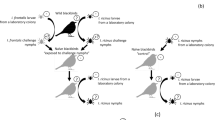Abstract
The Southern giant petrel (Macronectes giganteus) is declining over much of its range and currently is listed as vulnerable to extinction by the International Union for the Conservation of Nature (IUCN). Island-specific breeding colonies near Palmer Station, Antarctica, have been monitored for over 30 years, and because this population continues to increase, it is critically important to conservation. In austral summer 2004, six diseased giant petrel chicks were observed in four of these colonies. Diseased chicks were 6–9 weeks old and had multiple proliferative nodules on their bills and skin. One severely affected chick was found dead on the nest and was salvaged for necropsy. Histopathological examination of nodules from the dead chick revealed epithelial cell hyperplasia and hypertrophy with numerous eosinophilic intracytoplasmic inclusions (Böllinger bodies). A poxvirus was isolated from multiple nodules. Poxviral infection has not been reported in this species, and the reason for its emergence and its potential impact on the population are not yet known.




Similar content being viewed by others
References
Birdlife International (2006) Online world bird database, Cambridge: www.birdlife.org/datazone/species/index.html?action=SpcHTMDetails.asp&sid=3870&m=0
Bolte AL, Meurer J, Kaleta EF (1999) Avian host spectrum of avipoxviruses. Avian Pathol 28:415–432
Hansen W (1999) Avian pox. In: Friend M, Franson JC (eds) Field manual of wildlife diseases. USGS, National Wildlife Health Center, Madison, pp 163–169
Kerry K, Riddle M, Clarke J (1999) Diseases of Antarctic Wildlife, a report submitted to The Scientific Committee on Antarctic Research (SCAR) and The Council of Managers of National Antarctic Programs (COMNAP). Australian Antarctic Division, Hobart, Australia, pp 120
Kim T, Schnitzlein WM, McAloose D, Pessier AP, Tripathy DN (2003) Characterization of an avianpox virus isolated from an Andean condor (Vultur gryphus). Vet Microbiol 96:237–246
Kim TJ, Tripathy DN (2006) Antigenic and genetic characterization of an avian poxvirus isolated from an endangered Hawaiian goose (Branta sandvicensis). Avian Dis 50:15–21
Lee RE, Baust JG (1987) Cold-hardiness in the Antarctic tick Ixodes uriae. Physiol Zool 60:499–506
Leotta GA, Rivas M, Chinen I, Vigo GB, Moredo FA, Coria N, Wolcott MJ (2003) Avian cholera in a Southern Giant Petrel (Macronectes giganteus) from Antarctica. J Wildl Dis 39(3):732–735
Medina MF, Adolfo RG, Hernandez A (2004) Avian pox in white-tailed laurel-pigeons from the Canary Islands. J Wildl Dis 40(2):351–355
Patterson DL, Woehler EJ, Croxall, JP, Cooper J, Poncet, S, Fraser WR (2007) Breeding distribution and population status of the Northern Giant Petrel Macronectes halli and Southern Giant Petrel M. giganteus. Mar Ornithol (in press)
ProMED-mail (2006) Avian pox virus, penguins—Falkland Islands. ProMED-mail 2006; 24 Feb: 20060224.0611. http://www.promedmail.org. Accessed 25 February 2006
Van Riper C, Forrester DJ (2007) Avian pox. In: Thomas NJ, Hunter DB, Atkinson CT (eds) Infectious diseases of wild birds. Blackwell, Oxford, pp 131–176
Samour JH, Kaaden OR, Wernery U, Bailey TA (1996) An epornitic of avian pox in houbara bustards (Chlamydotis undulata macqueenii). Zentralbl Veterinarmed B 43(5):287–292
Smits JE, Tella JL, Carrete M, Serrano D, López G (2005) An epizootic of avian pox in endemic short-toed larks (Calandrella rufescens) and Berthelot’s pipits (Anthus berthelotti) in the Canary Islands, Spain. Vet Pathol 42:59–65
Thiel T, Whiteman NK, Tirape A, Baquero MI, Cedeno V, Walsh T, Uzcatequi GJ, Parker PG (2005) Characterization of canarypox-like viruses infecting endemic birds in the Galapagos Islands. J Wildl Dis 41(2):342–353
Tripathy DN, Reed WM (2003) Pox. In: Saif YM (eds) Diseases of poultry. Iowa State Press, Iowa, pp 253–269
Van Riper C, Van Riper S, Hansen WR (2002) Epizootiology and effect of avian pox on Hawaiian forest birds. Auk 119(4):929–942
Vargas H (1987) Frequency and effect of pox-like lesions in Galapagos mockingbirds. J Field Ornithol 58(2):101–102
Voisin JF (1988) Breeding biology of the Northern Giant Petrel Macronectes halli and the Southern Giant Petrel M. giganteus at Ile de la Possession, Iles Crozet, 1966–1980. Cormorant 16:65–97
Wages DP, Opengart K (2003) Necrotic enteritis. In: Saif YM (eds) Diseases of poultry. Iowa State Press, Iowa, pp 781–785
Wobeser GA (1997) Diseases of wild waterfowl. Plenum, New York
Acknowledgments
The technical assistance of Renee R. Long, Brenda Berlowski, and Mauritz Sterner are gratefully acknowledged. Antarctic fieldwork was supported by grants OPP-9910095, OPP-0130525 and OPP-0217282 to W. R. Fraser.
Author information
Authors and Affiliations
Corresponding author
Rights and permissions
About this article
Cite this article
Shearn-Bochsler, V., Green, D.E., Converse, K.A. et al. Cutaneous and diphtheritic avian poxvirus infection in a nestling Southern Giant Petrel (Macronectes giganteus) from Antarctica. Polar Biol 31, 569–573 (2008). https://doi.org/10.1007/s00300-007-0390-z
Received:
Revised:
Accepted:
Published:
Issue Date:
DOI: https://doi.org/10.1007/s00300-007-0390-z




